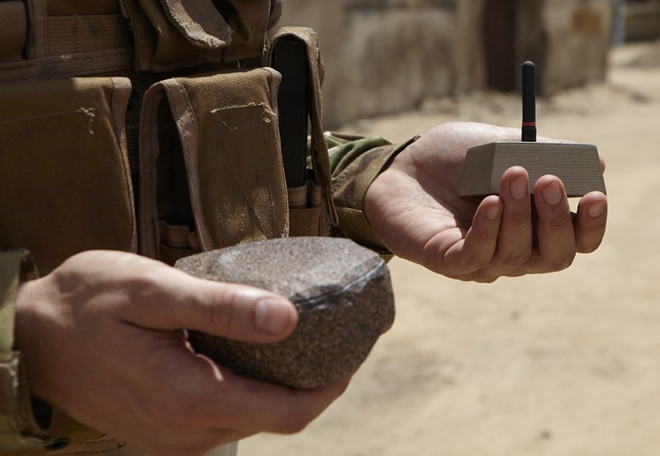This rock could spy on you for decades
May 30, 2012
After U.S. forces depart Afghanistan in 2014, palm-sized sensors, some disguised as rocks or buried, with wafer-sized, solar-rechargeable batteries that could enable the sensors’ operation for perhaps as long as two decades, will remain littered across the Afghan countryside, Wired Danger Room reports.
These “field and forget” systems for “persistent surveillance” will be able to detect anyone who moves nearby and report their locations back to a remote headquarters.
“Were going to leave behind a lot of special operators in Afghanistan. And they need the kind of capability that’s easy to put out so they can monitor a village without a lot of overt U.S.-made material on pathways and roadways,” says Matt Plyburn, an executive at Lockheed Martin, the world’s largest defense contractor.
The U.S. Customs and Border Patrol today employs more than 7,500 UGSs on the Mexican border to spot illegal migrants. Defense contractors believe one of the biggest markets for the next generation of the sensors will be here at home.
“They could be used for border security or even around corporate headquarters,” Plyburn tells Danger Room.
Soon, when one of the sensors picks up a signal, it’ll queue a spy blimp to focus in on the spot. “That’s a capability coming to a theater near you soon,” he adds.
Even more sophisticated are the UGSs being tested northeast of Norfolk, Virginia, at a Lockheed proving ground. Arrays of up to 50 palm-sized acoustic and seismic sensors form a mesh network. When one sensor detects a person or a vehicle passing by, it uses unlicensed radio frequency bands to pass an alert from one node to the next. The alert finally hits a communications gateway, which can send the signal via satellite, tactical radio network, or Wi-Fi to a command and control center. That signal can tip off additional sensors — or it can send a Twitter-like message to an intelligence officer’s phone or tablet.
Plyburn says each sensor could cost as little as $1,000 each — practically expendable for a military paying $80,000 for a single guided artillery round.
Lockheed isn’t the only company claiming that its sensors can operate for years on end. U.S. Special Operations Command has handed out at least $12 million in UGS contracts to tiny Camgian Microsystems, based out of Starksville, Mississippi. Company CEO Gary Butler, who spent years developing ultra-low power integrated circuits for Darpa, was awarded in March a patent for such a next-gen unattended sensor suite.
Rather than relaying alerts from node to node, each of Butler’s sensors is designed to send signals directly to a satellite — speeding up notifications, and cutting down on power consumed. Rather than a simple acoustic or seismic detector, the sensor relies a steerable, phased-array radar and moving-target indicator algorithms. That could give it a much greater ability to detect people and vehicles on the run. High-powered solar cells provide will enable up to “500,000 recharge cycles” could give the sensor a “10-20 year life,” according to the patent.
Camgian’s patent claims that the sensor’s ease-of-use and small size means it “is easily emplaced in difficult areas, using airborne assets such as Unmanned Aerial Vehicles.” Edward Carapezza, who has been overseeing UGS research for more than two decades, says drones are already dropping unattended sensors into hostile locations.
“In certain areas, we certainly are using unmanned vehicles and unattended sensors together,” says Carapezza, who now works at the defense contractor General Atomics. He declined to name where these operations were being conducted. He simply gave the rationale for the missions. “Instead of sending patrols of our guys in, we send in drones and unattended sensors — dropping arrays, locating bad guys, and then putting weapons on target.”
